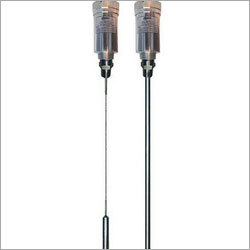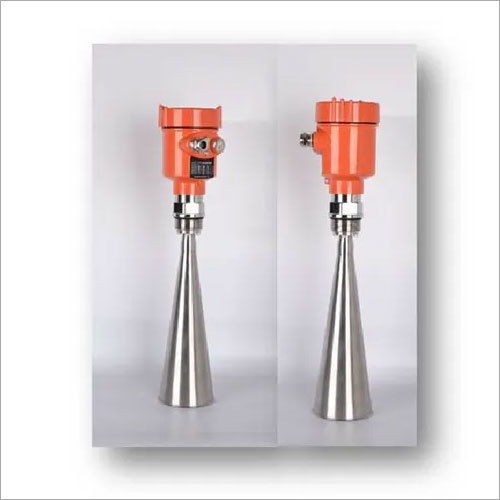- Home Page
- Company Profile
-
Our Products
- Level Switches
- Admittance Point Level Switches
- Conductivity Level Switch
- Vibrating Fork Level Switch for Solid Application
- RF Level Switches for ESP Hopper
- Rotating Paddle Point Level Switches
- Boot Level Switches
- 002 RF Level Switch
- Float Level Switch
- Honeybee Level
- Liquid Tuning Fork Point Level Switch
- Vibrating Rod Point Level Switches
- 006 vibrating fork Harp
- 005 Conducttivity Level Switch
- 003 Roating Paddle level switch
- Vibrating Fork Level Switch
- Flow Meters
- Level Transmitters
- Moisture Sensors
- Radar Level Transmitter
- Ultrasonic Level Transmitter
- Level Switches
- Contact Us

TDR Level Transmitter
Product Details:
- Frequency 500 MHz1.8 GHz
- Input Current <75 mA
- Efficiency Industrial Standard
- Phase Single Phase
- Protection Level IP67 / IP68
- Mounting Type Threaded or Flanged
- Humidity 0100% RH
- Click to view more
X
TDR Level Transmitter Price And Quantity
- 150 Unit
- INR
TDR Level Transmitter Product Specifications
- Threaded or Flanged
- IP67 / IP68
- 24 V DC
- 0100% RH
- Industrial
- 420 mA
- 316L Stainless Steel, PP
- Mounting Flange, User Manual
- Electric
- <75 mA
- 1836 V DC
- Continuous Level Measurement in Liquids and Bulk Solids
- New
- 500 MHz1.8 GHz
- 450 x 125 x 110 mm
- Industrial Standard
- <1.2 W
- Single Phase
- Level Transmitter (Guided Wave Radar)
TDR Level Transmitter Trade Information
- Telegraphic Transfer (T/T), Cheque
- 200 Unit Per Month
- 1 Week
- Yes
- Contact us for information regarding our sample policy
- Australia, North America, Eastern Europe, South America, Western Europe, Africa, Central America, Middle East, Asia
- All India
Product Description
TDR Level Transmitter
With our years of intensive experience and sound knowledge in this industry, our company has been able to mark its strong presence in the market as one of the excellent manufacturers & suppliers of TDR Level Transmitter. These transmitters are broadly used during continuous level measurement of powdery & granular bulk solids such as plastic granulate and liquids like oil & water. Due to features such as robust construction, high accuracy and superior strength, TDR Level Transmitter is demanded among our clients.
Further Details:
Supplier & Manufacturer of TDR Level Transmitter. Our product range also comprises of Level Transmitter, Aquafork Point Level Switch For Liquids and Radar Level Transmitter For Liquid.
Application
Probes are available with threaded process connections from 1/2".
- Rope probes, above all for measurement, Measuring range up to 35 m
- Rod probes, above all for liquids, measuring range up to 7m
- The following interfaces are available for system Integration:
- HART (standard),
- RS485 or RS232 (Modbus RTU)
- 4-20mA/20-4mA output
- Accuracy Grade: +0.1%+0.25%
- Resolution: +3mm
- Environment temperature: -40~140 oF(-40~60oC)
- Operating temperature: -40~482 oF(-40~60oC))
- Power is 16~38VDC 9W
- Two wire
- Frequency mode is pulse
- Material of enclosure is standard aluminium or stainless steel as 316SS
- Material of antenna is stainless steel as 316SS
- Calibration can made through the control panel or software in the measurement range
- There is FCC15 low power communicator; FM explosion proof, ULCAN/CSA
- Grade of Protection is NEMA4X (IP65)
Installation
General installation instructions
Probe selection
- Normally, rope probes should be used for bulk solids; rod probes are only suitable for short measuring ranges
- Normally use rod probes for liquids. Rope probes are used in liquids for measuring ranges > 4m and with restricted ceiling clearance which does not allow the installation of rigid probes.
- In the case of large silos, the lateral pressure on the rope can be so high that a rope with plastic jacketing must be used. We recommend PA-coated ropes be used for cereal products wheat, flour etc...
Installation in the nozzle stub as DN200/8" and DN250/10"
If the sonsor is installed in the stub with dia> 200mm/8", the echo produced by stub inside wall would cause measurement error under low dielectric constant condition. Therefore, a special flange with horn interface should be provided for the installation. Avoid installing in the stub with dia, 250/10". If bend happens to the rope probe, we recommend selecting an extension rod to fix the middle ring.
Optimization options
Interference echo suppression: Measurement can be optimized by electronically tuning out Interference echoes.
Mounting location
- Do not mount rod or rope probes in the feed inlet or outlet
- Mount rod and rope probes away from the bin wall Mount at such a distance as 1/4 of bin's diameter
- The minimum distance from bin wall to rod or rope probes should be more than 50cm
- Distance of obstacle in the bin from the rod and rope probes shoule be >300mm
- When installing rod and rope probes in plastic containers, keep the probe away from container wall in the whole measuring process, when installed in a metallic container, don't install the sensor at the center if the container.
- Minimum distance of probe end to the container floor is around 30mm
- When installing outdoors, it is recommended that you use a protective cover (1) see "Accessories" on
- If container's bottom shape is conical, the sensor can be installed in the top center of the container. The below Figure is the mouting of radar with rod probe, mainly for liquid level measurement.
Robust and Versatile Level Monitoring
Engineered for industrial applications, the TDR Level Transmitter ensures accurate performance across a wide range of environments. Featuring a probe range up to 30 meters and precision within 3 mm, it handles both liquids and bulk solids with ease. Its rugged enclosure options and IP67/IP68 protection enable deployment in demanding areas, while accessories such as mounting flanges increase its adaptability to various installation requirements.
Flexible Communication and Control
This device is equipped with advanced communication interfaces, supporting both HART and RS485 protocols for seamless integration. Users benefit from remote parameterization through HART, allowing adjustments without direct contact. Whether your system demands threaded or flanged process connections, or varied voltage configurations, this transmitter fits effortlessly into existing workflows, ensuring efficient and streamlined monitoring.
FAQs of TDR Level Transmitter:
Q: How does the TDR Level Transmitter achieve accurate level measurement?
A: The device utilizes guided wave radar (Time Domain Reflectometry) to send microwave pulses along a probe. By measuring the time taken for the pulses to reflect back from the mediums surface, the transmitter reliably calculates the precise leveleven with a 3 mm accuracy.Q: What process connections are available for this level transmitter?
A: The transmitter accommodates a variety of process connections, including threaded (G1", G2"), flanged (DN50), and custom fittings, making it adaptable to most tanks and vessels commonly found in industries such as chemicals, water treatment, and food processing.Q: When should the explosion-proof option be considered?
A: The explosion-proof version (Ex ia IIC T6 Ga/Gb) is recommended when installing the device in hazardous environments where explosive gases or vapors may be present. This ensures compliance with strict safety requirements and enhances operational safety.Q: Where can this transmitter be used?
A: It is designed for continuous level measurement in a broad spectrum of industries and is suitable for liquids, slurries, and bulk solids. Its robust construction and IP67/IP68 ingress protection allow it to be installed both indoors and outdoors, even in demanding or wet conditions.Q: What are the benefits of remote parameterization via HART?
A: Remote parameterization streamlines setup, calibration, and troubleshooting by allowing adjustments from a safe location. This reduces downtime, increases operational safety, and facilitates real-time optimization without physical access to the transmitter.Q: How is the transmitter powered, and what are its electrical requirements?
A: It operates on 1836 V DC, typically at a rated voltage of 24 V DC, consuming less than 1.2 W of power and drawing under 75 mA. This makes it energy-efficient while maintaining high performance in single-phase industrial environments.Tell us about your requirement

Price:
Quantity
Select Unit
- 50
- 100
- 200
- 250
- 500
- 1000+
Additional detail
Mobile number
Email



 Call Me Free
Call Me Free
